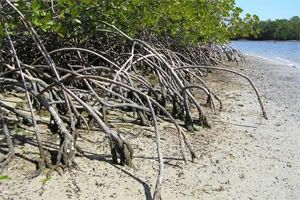
photo credit NPS
A new map made from satellite data shows the world's mangrove forests are far smaller than previously estimated. Only about 6.9% of them are currently protected.
Mangroves are amazingly important plants. Trees, palms and shrubs of the species have evolved to live in the harsh environmental conditions of extreme salinity, high temperatures and substantial tidal differences. The intricate root systems help to slow turbulent waters and keep sediments in place. For these reasons they are an important nursery for young marine life and are also a front-line defence during hurricanes, tropical storms and other sources of beach and island erosion.
I spent some time in Belize in college, and one of our guides explained to us that a lot of rich foreigners came into the cayes to buy private islands. They found the mangrove trees that lined the islands unattractive and had them removed, thus removing the island's natural protection. These islands no longer exist, because without the mangroves to hold everything together, the islands were literally swept away!
"It is believed that 35 percent of mangrove forests were lost from 1980 to 2000," says Chandra Giri, of the U.S. Geological Survey, "which has had an impact on the coastal communities that use mangrove forests as a protective barrier from natural disasters, such as hurricanes and tsunamis."
Full article here (Our Amazing Planet) - Click to see the map generated by the satellites!
No comments:
Post a Comment